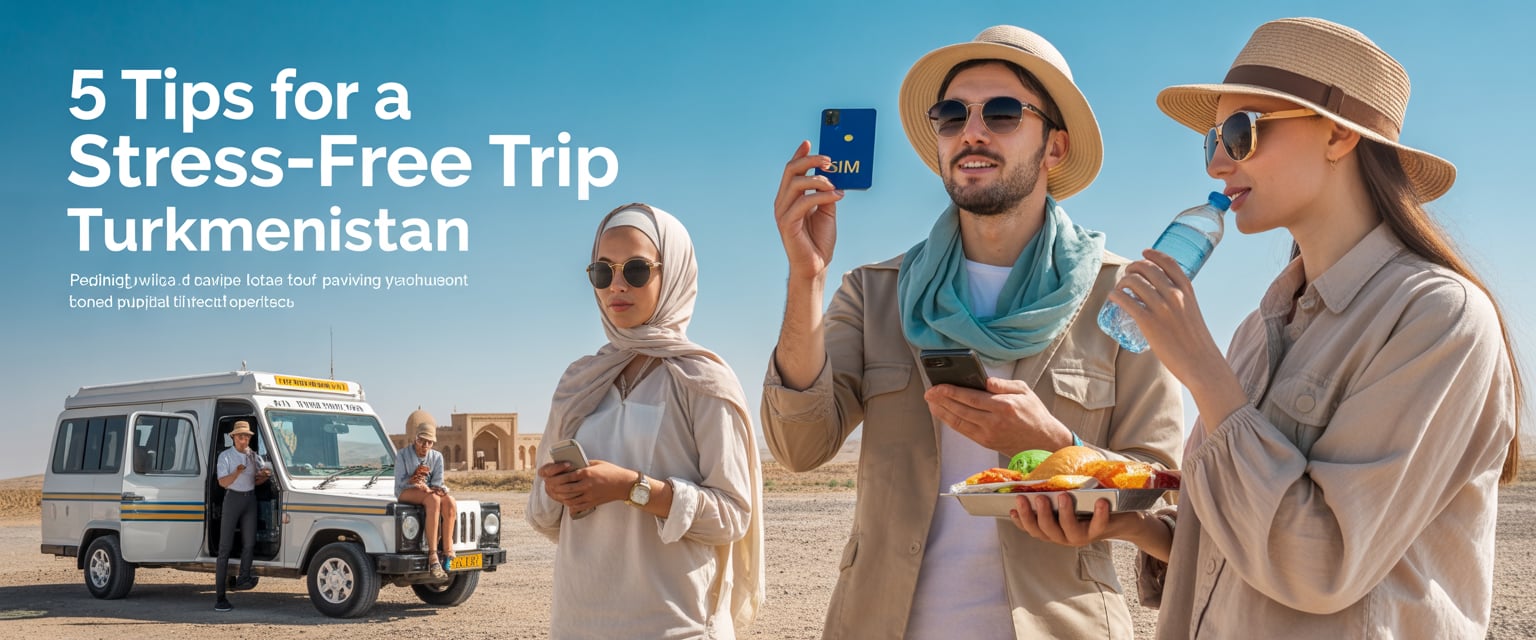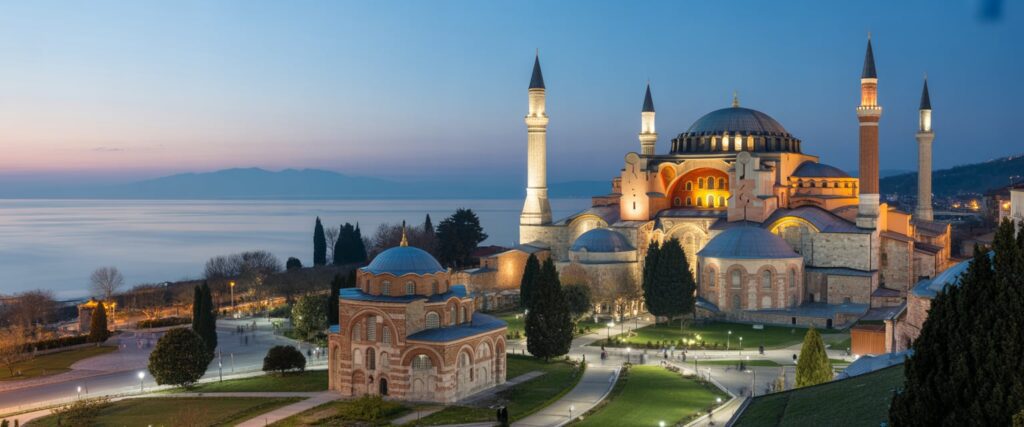Turkmenistan is a land of striking contrasts—golden deserts, glowing craters, white-marble cities, and ancient Silk Road wonders—and exploring it becomes even easier when travelers rely on the Top 7 Turkmenistan Tourism Packages You Must See: Best Spots & Tips crafted for unforgettable experiences.
From Ashgabat’s dazzling architecture to the remote beauty of Yangykala Canyon, each curated journey reveals a new side of this Central Asian jewel. Whether visitors seek cultural immersion, historical exploration, or desert adventure, the Top 7 Turkmenistan Tourism Packages You Must See: Best Spots & Tips ensure a seamless, well-planned entry into one of the world’s most unique and rarely explored destinations.
Table of Contents
Top 7 Turkmenistan Tourism Packages You Must See
Turkmenistan stands out as one of Central Asia’s most intriguing destinations, offering a mix of desert landscapes, marble architecture, and ancient history. From the fiery Darvaza Gas Crater to the grand monuments of Ashgabat, the country blends modern design with Silk Road heritage. Those planning a trip can find the best tourism packages that highlight both famous landmarks and hidden gems while staying within budget.
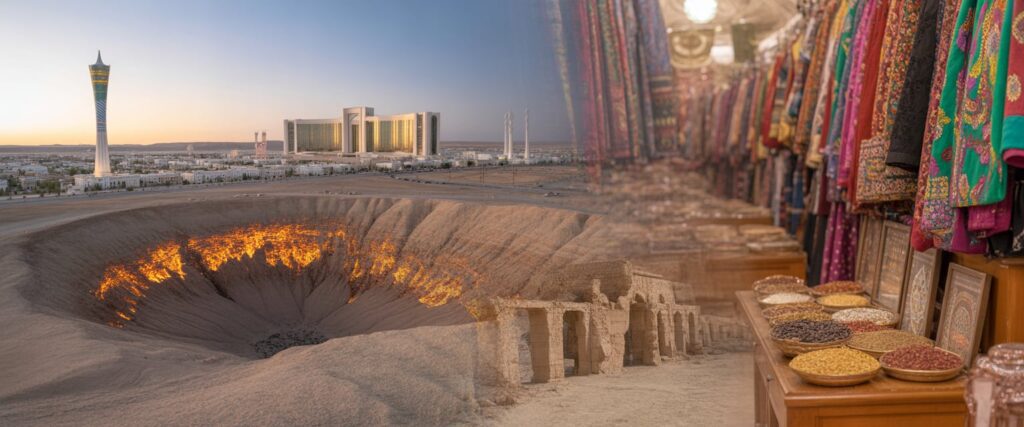
Travelers can expect to discover stunning sites like the ancient ruins of Merv, underground lakes, and sprawling bazaars. The blog explores must-visit attractions, essentials for Indian and international tourists, and valuable cultural insights to navigate Turkmenistan with ease. It also covers key topics such as the national currency, visa information, and local customs to ensure a smooth and memorable visit.
Each section offers practical details, from understanding Turkmenistan’s religion and etiquette to learning what every traveler should know about its capital city. With this guide, anyone planning a trip can explore confidently, knowing what to expect in this unique corner of Central Asia.
Travelers to Turkmenistan can explore ancient Silk Road cities, vast deserts, and modern marvels. From the marble skyline of Ashgabat to the glowing Darvaza gas crater, this Central Asian nation offers a mix of history, culture, and striking natural beauty.
Best Ashgabat Experiences for Travelers
Ashgabat, the capital of Turkmenistan, impresses visitors with its white marble buildings, grand monuments, and clean streets. Many tour packages include stops at Independence Square, the Neutrality Arch, and the Ertugrul Gazi Mosque. The city also features modern landmarks like the Alem Cultural Center and indoor Ferris wheel, both record-holding attractions highlighted in guides such as 7 Best Tourist Attractions in Turkmenistan.
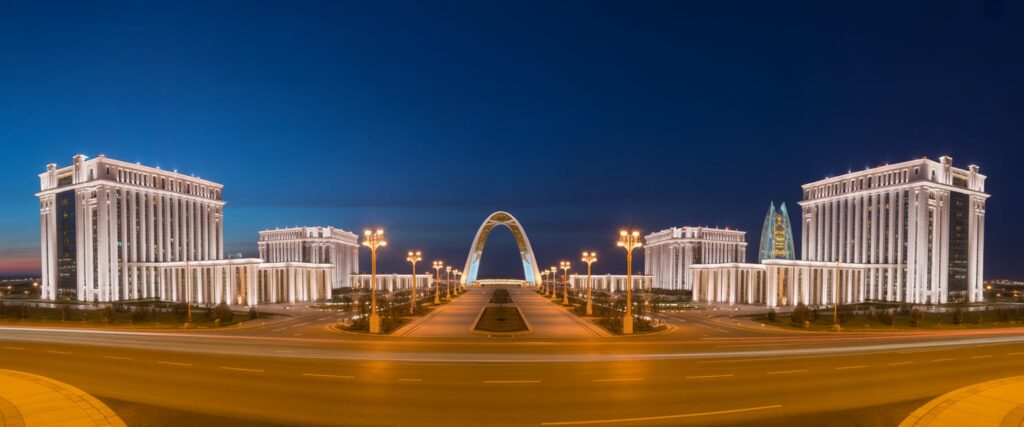
Evenings in Ashgabat come alive when the city’s architecture glows under bright lights. Travelers can visit the massive Turkmen Carpet Museum or browse local crafts at Tolkuchka Bazaar. Those seeking a cultural glimpse can plan visits around national celebrations, which display traditional Turkmen music, dance, and dress.
Exploring the Ancient Ruins of Merv
Ancient Merv, a UNESCO World Heritage site, showcases the layered history of the Silk Road. Once one of the world’s largest cities, it connected Central Asia with Persia and China. Key sites within the archaeological park include the Mausoleum of Sultan Sanjar, the Kyz Kala fortress, and the remains of ancient walls that stretch across the desert plain.
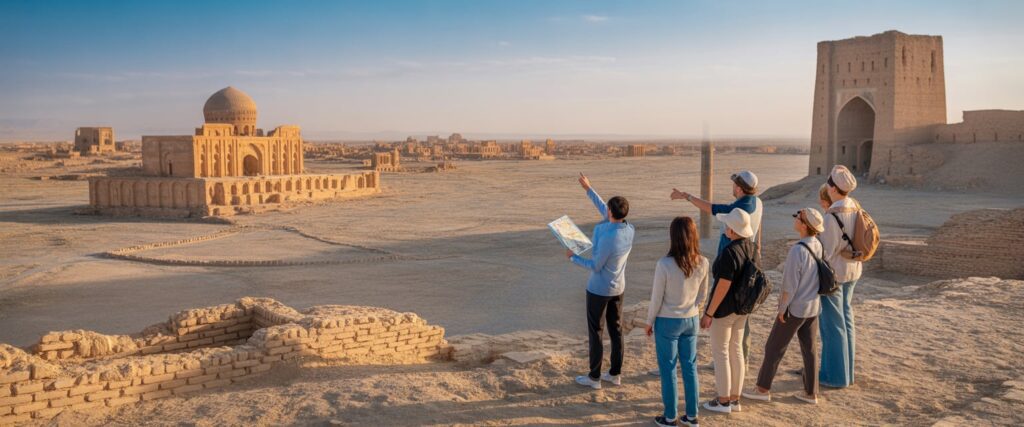
Visitors often join guided history tours that explain how Merv thrived between the 6th and 13th centuries. Since heat can be intense, it is best to visit early morning or late afternoon. Merv’s layout helps travelers envision how trade caravans and scholars once filled its streets.
Darvaza Gas Crater: Discover the Door to Hell
Located in the Karakum Desert, the Darvaza Gas Crater—often called the Door to Hell—is one of Turkmenistan’s most remarkable natural wonders. This site formed in 1971 when drilling released gas that engineers ignited to prevent methane escape. The flames have burned ever since, creating a glowing crater roughly 60 meters wide and 20 meters deep.

Adventure tours usually include overnight stays in desert camps near the crater. Visitors can watch the fire pit at sunset, when the light intensifies against the dark desert night. The area also draws photographers for its rare combination of isolation and striking color.
Unforgettable Caspian Sea Tours and Avaza Resort
The Caspian Sea coast in western Turkmenistan offers a quiet contrast to the desert interior. The Avaza National Tourist Zone near Turkmenbashi features modern hotels, beaches, and promenades. Travelers looking for comfort can enjoy resort packages that include boat excursions, spa treatments, and local seafood dining.
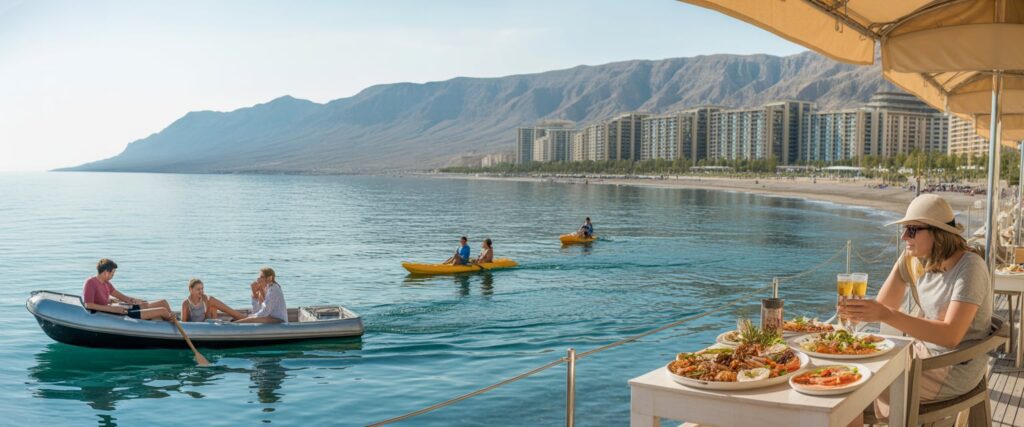
Some group trips combine Avaza with visits to the nearby Balkan Mountains or short cruises along the coast. The water’s calm conditions make it suitable for family-friendly swimming and kayaking. Though not as known as Mediterranean resorts, Avaza provides a peaceful seaside escape within Turkmenistan’s tourism network.
Cultural Heritage Along the Silk Road
Turkmenistan’s place on the Silk Road shaped its art, architecture, and customs. Cities like Mary and Balkanabat reveal traces of caravan trade through surviving bazaars and Islamic monuments. Traditional crafts, such as handwoven carpets and silver jewelry, remain part of daily life.

Travel agencies often offer cultural circuits linking Nisa Fortress, Konye-Urgench, and Ancient Merv. These itineraries help travelers understand how empires like the Parthians and Seljuks influenced Turkmen history. Visitors can also attend folk performances featuring the dutar, a two-stringed instrument emblematic of the region’s musical heritage.
Marvels of Dashoguz and Konye-Urgench
Located in northern Turkmenistan, Dashoguz Province holds one of the country’s most important archaeological areas—Konye-Urgench. Once a thriving Silk Road city, it contains monuments such as the Kutlug-Timur Minaret and Turabek-Khanum Mausoleum. The site’s historical significance and architectural detail make it one of the top places to visit in Turkmenistan described by Travelho’s list of top destinations.
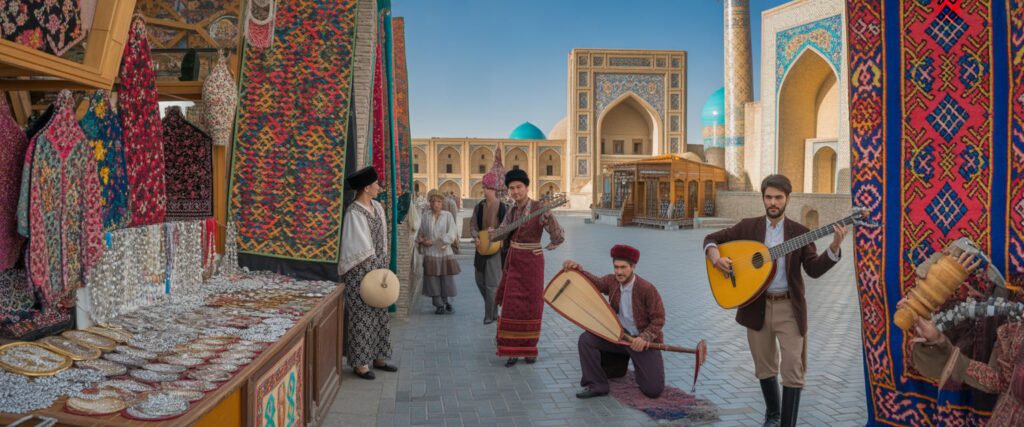
Day trips from Dashoguz let travelers explore preserved mausoleums and old caravan routes. Many people also visit local markets where craftspeople sell embroidered textiles and ceramics. Tour itineraries often include stops along the Amu Darya River, highlighting the agricultural richness of the area.
Yangykala Canyon & Nokhur Village Getaways
Yangykala Canyon, in the Balkan region, provides some of the most dramatic landscapes in the country. Its pink, red, and white cliffs stretch for miles, shaped by wind and erosion. Trips by jeep or 4×4 take visitors through remote desert terrain to scenic overlooks used in national tourism campaigns such as 12 Stunning Places in Turkmenistan.
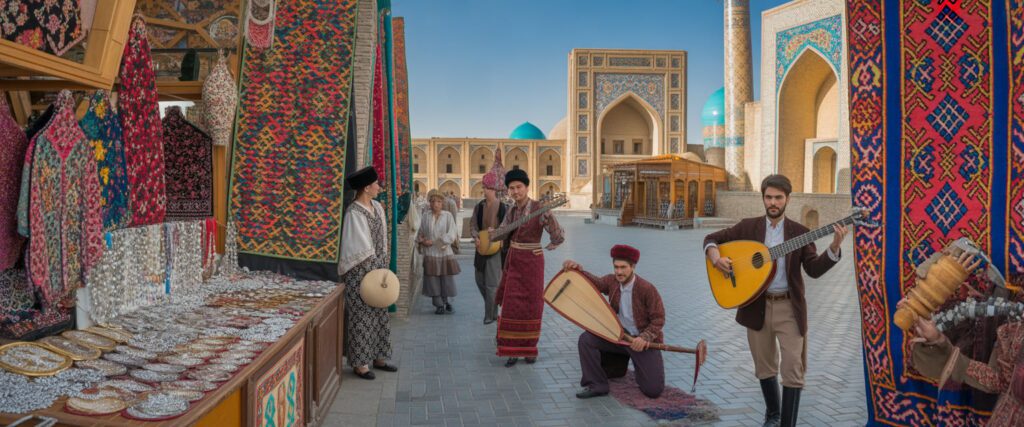
Nearby Nokhur Village offers a cultural contrast to the canyon. This mountain settlement is known for its ancient cemetery decorated with mountain goat horns and for its handwoven textiles. Travelers can stay in family guesthouses, taste local tea, and learn about Nokhuri customs passed down for generations. Combining these visits gives a balance between Turkmenistan’s nature and living traditions.
Turkmenistan Capital: 7 Essential Facts for Every Traveler
Ashgabat, the marble-filled capital of Turkmenistan, blends futuristic design with traces of ancient Silk Road history. Travelers experience a city shaped by ambitious architecture, calm public spaces, and a strong sense of national pride.
Ashgabat’s Modern Landmarks and Architecture
Ashgabat stands out for its white-marble buildings, which earned it recognition from Guinness World Records for the highest density of marble-clad structures. Key sites include the Independence Monument, the Neutrality Arch, and the vast Alem Cultural and Entertainment Center. These landmarks reflect Turkmenistan’s post-independence modernization and the government’s focus on national identity.
The Turkmen Carpet Museum showcases intricate handwoven carpets, a major symbol of Turkmen art. Many visitors also explore Ashgabat’s modern architecture, which blends traditional motifs with bold, geometric forms. At night, entire districts glow in white and gold lights, creating a striking contrast with the desert backdrop.

Large public squares and fountains line the streets, and monuments such as the Eternal Flame Memorial honor the country’s history. Visitors often find the city’s clean, organized layout ideal for walking tours or guided photo excursions.
Cultural Experiences in the Capital
Ashgabat’s cultural life centers on museums, parks, and local markets. The Tolkuchka Bazaar remains a key stop for travelers seeking local crafts, traditional hats, and fine carpets. Museums such as the National Museum of Turkmenistan display archaeological finds from ancient sites like Merv and Nisa, both UNESCO World Heritage locations.
Music, dance, and art festivals take place throughout the year, highlighting Turkmen traditions. The Akhal-Teke horse, a national symbol, features prominently in performances and parades. Many travelers visit museums or attend concerts arranged by their licensed guides since independent exploration is limited, as noted in the Turkmenistan travel guide.

Restaurants serve Central Asian and Russian cuisine, including plov, kebabs, and freshly baked flatbread. Alcohol is legal and sold in most city establishments, though responsible consumption is encouraged.
Getting Around Ashgabat: Tips for Tourists
Public transportation includes buses and taxis, but most travelers rely on prearranged tours or private drivers. Foreign visitors generally need a licensed guide when traveling outside Ashgabat. Within the city, movement is easy, roads are well maintained, and traffic is light.
The local currency, Turkmen Manat (TMT), is used everywhere, though paying with small denominations is helpful. Visitors are encouraged to bring cash, as card use remains limited. Internet access is heavily restricted, and SIM cards are available through tour guides.
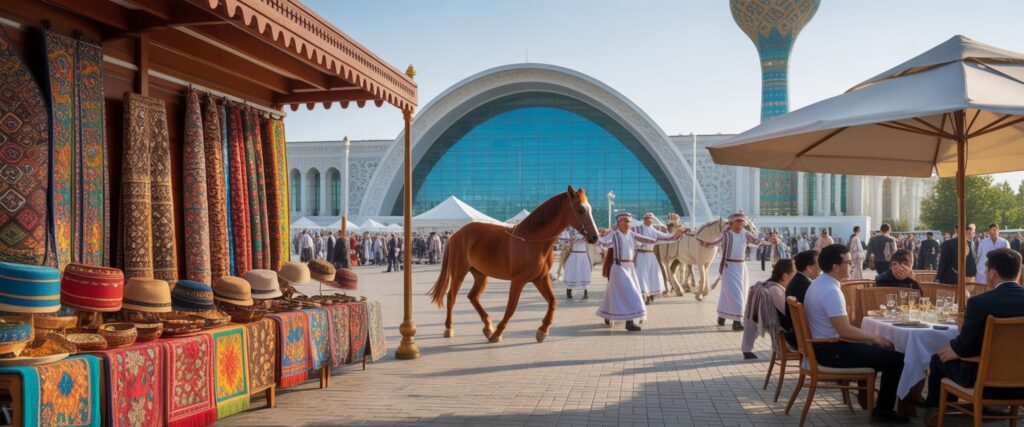
Safety levels are high, with low petty crime rates and visible police presence. Tourists should still follow local regulations, especially about photography. Taking photos near government buildings or military areas may be restricted, so checking with guides before shooting is advisable.
Turkmenistan Travel Essentials for Indians and International Visitors
Travelers planning a trip to Turkmenistan should understand visa procedures, currency use, and common visitor expenses before arrival. This information helps avoid unexpected delays, financial issues, and confusion when dealing with local travel rules or payments.
Visa Requirements for Indian Travelers in 2025
As of 2025, Indians must obtain a Turkmenistan tourist visa before traveling. The government now supports an electronic visa system that allows most foreigners, including Indians, to apply online, replacing the previous mandatory Letter of Invitation (LOI) for many visitors. Details about the change appear in updated travel guidelines.
Applicants complete the e-visa form, upload a passport scan valid for at least six months, and pay the processing fee electronically. Visa processing typically takes about 10 working days, depending on embassy workload or online verification speed.
Those entering via land borders with Uzbekistan, Iran, or Kazakhstan might still need prior authorization or an LOI, as noted in practical border details from Nomads Life’s Turkmenistan guide.
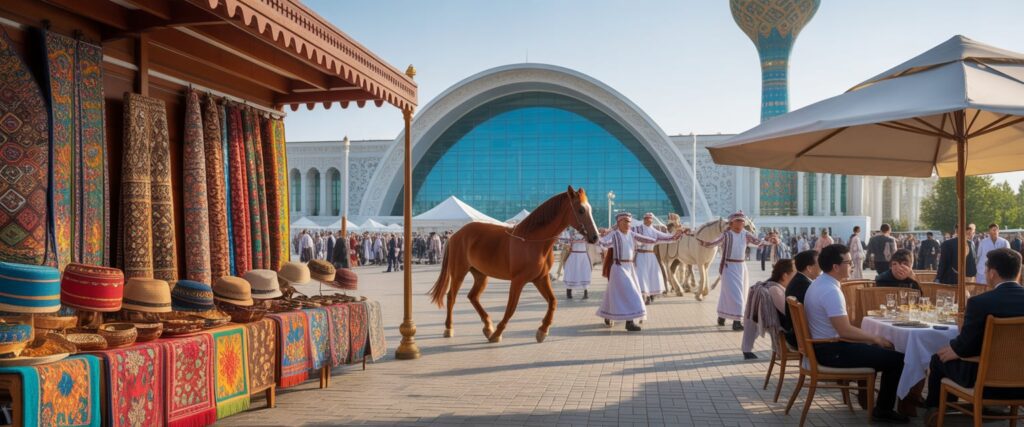
After arrival, visitors must register their stay within three working days through their hotel or tour operator. Carrying a copy of this registration is essential, especially when traveling between regions like Ashgabat, Merv, or Dashoguz.
Turkmenistan Currency Guide: 5 Must-Know Facts
- The official currency is the Turkmenistan manat (TMT).
- Exchange rates can differ between banks and unofficial money changers. Using licensed exchange counters offers the most reliable rate.
- Credit cards are accepted only in select hotels and shops in Ashgabat. Cash remains the main form of payment outside the capital.
- ATMs are limited, and many work only with local bank cards. International visitors should bring US dollars in small denominations for easy exchange.
- Currency export rules limit the amount of manat travelers can take abroad. Exchanging excess cash before departure helps avoid issues at customs.
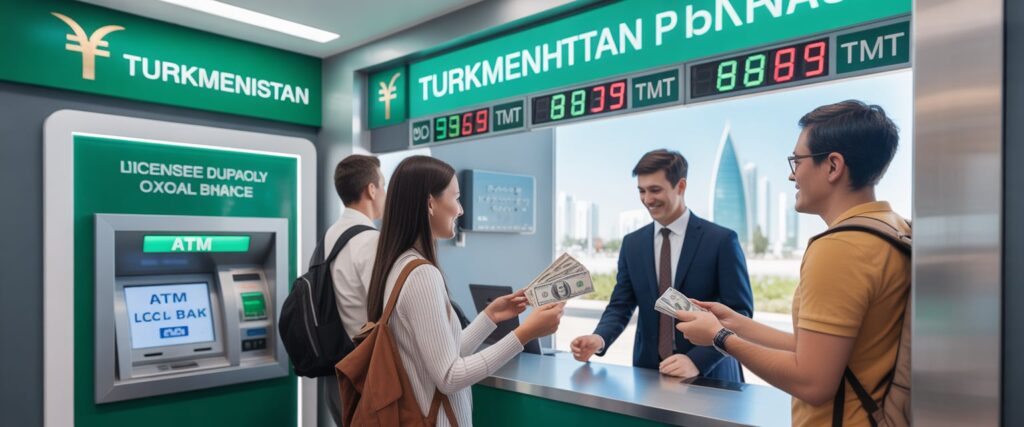
Keeping money in both USD and local currency reduces inconvenience in smaller towns or markets.
Best Budget Tourism Packages and Tips
Tour operators in Turkmenistan offer group and private packages ranging from short city visits to multi-day desert tours. For travelers on a tight budget, three to five-day itineraries covering Ashgabat, Nisa ruins, and the Darvaza Gas Crater provide value and compact scheduling. Websites such as Next Journey Ahead list itineraries that combine major landmarks and transportation details.
Budget travelers can reduce costs by sharing accommodation, using local eateries, and booking tours directly through local operators instead of third-party agents. Travelers arriving from India may find off-season rates between June and August due to higher summer temperatures.
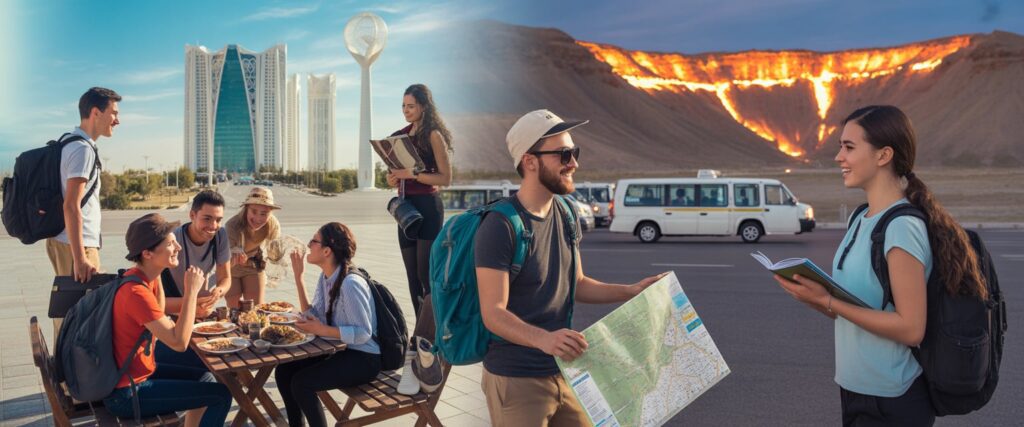
Public buses and shared taxis connect major towns cheaply. Always reconfirm pickup times with tour guides, as schedules can shift with road conditions.
5 Tips for a Stress-Free Trip
1. Plan communication early. SIM cards are inexpensive but require registration with identification. Wi-Fi speeds vary outside Ashgabat.
2. Pack for the climate. Turkmenistan’s desert environment means hot days and cool nights. Light cotton clothing, a hat, and sunscreen are practical.
3. Respect customs. Most of the population follows Islam. Dress modestly in rural areas and avoid taking photos of government buildings.
4. Stay hydrated and eat carefully. Bottled water is safest, and it’s best to avoid uncooked food from street stalls.
5. Use reliable transport and tour operators. Prearranged vehicles through approved agencies ensure compliance with route permits for foreign visitors.
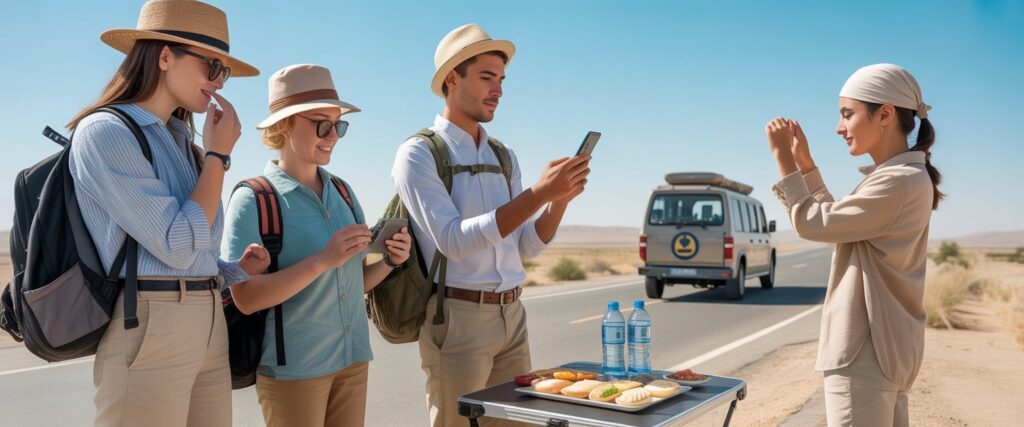
Following these steps helps travelers focus on enjoying Turkmenistan’s history and landscapes instead of managing travel logistics.
Understanding Turkmenistan Religion and Culture
Religion and culture in Turkmenistan shape daily life, from hospitality practices to national celebrations. Visitors who understand local beliefs and customs experience smoother travel and gain deeper appreciation for the country’s traditions. Respect, modesty, and awareness of social norms help travelers build positive connections with locals.
Key Insights into Religion for Visitors
Most Turkmen identify as Sunni Muslims following the Hanafi school of Islam. Religion plays a quiet yet steady role in family life and community values. While Turkmenistan maintains a secular government, Islamic holidays such as Kurban Bayram (Eid al-Adha) and Oraza Bayram (Eid al-Fitr) remain important cultural events.
Mosques can be found across the country, including notable sites like the Kipchak Mosque, one of Central Asia’s largest. Non-Muslims may visit most mosques outside of prayer times, but modest dress is expected. Women should cover their heads and shoulders, while men should wear long pants.
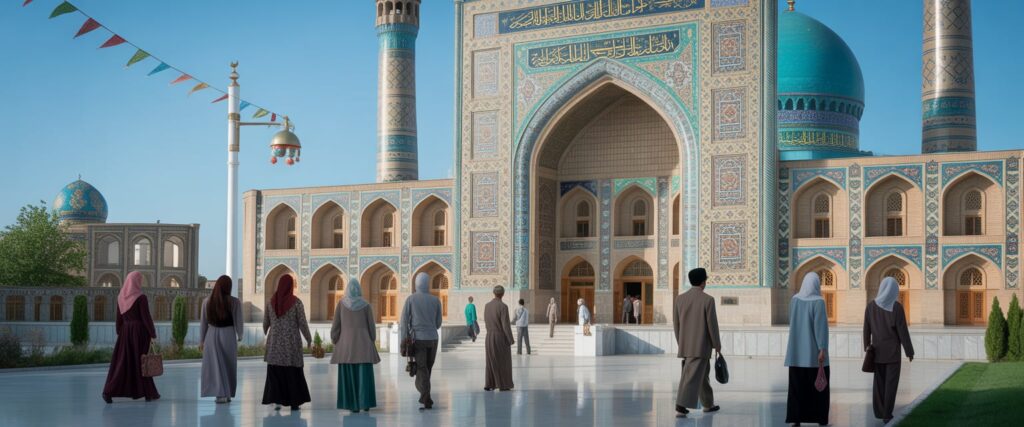
Religious freedom exists but is carefully regulated. Churches and other religious institutions are present, though small in number. Most people practice faith privately and show tolerance toward others. Visitors should avoid political or religious debates, especially in public spaces. Showing respect for Islam, even by simple gestures like avoiding alcohol in public, leaves a positive impression.
Cultural Etiquette and Visitor Guidelines
Turkmen culture values hospitality and respect for elders. Guests are often offered tea and bread upon arrival, a sign of goodwill that should never be declined. When greeting others, use a light handshake, and place the right hand over the heart as a polite gesture.
Dress modestly throughout the country. Women should wear long skirts or dresses, and men are advised to avoid shorts. In rural areas, dress codes are more conservative than in the capital, Ashgabat.
Photography requires care. Always ask permission before taking pictures of people, especially women, or government buildings. Locals take great pride in traditional carpets and the famous Ahal-Teke horses, symbols of Turkmen heritage celebrated in museums such as the Turkmen Carpet Museum featured on Visit Turkmenistan.
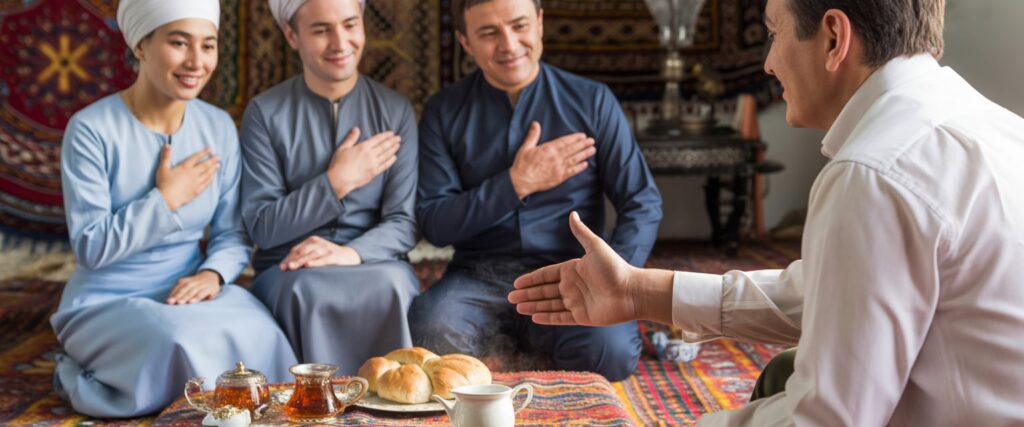
Public displays of affection are uncommon and should be avoided. Patience, politeness, and curiosity about Turkmen customs help travelers form lasting, respectful connections during their stay.
Conclusion
Turkmenistan offers an extraordinary blend of history, natural beauty, and modern marvels—an adventure enriched by choosing the right travel itinerary from the Top 7 Turkmenistan Tourism Packages You Must See: Best Spots & Tips. From the fiery Darvaza Crater to the peaceful Caspian coastline and centuries-old ruins, the country rewards curious travelers with unforgettable sights and cultural depth. With proper planning, respect for local customs, and guidance from the Top 7 Turkmenistan Tourism Packages You Must See: Best Spots & Tips, every visitor can enjoy a safe, insightful, and inspiring journey through this captivating Silk Road nation.
Frequently Asked Questions
Turkmenistan offers a mix of natural wonders, ancient history, and modern sights. Travelers can visit fiery craters, UNESCO World Heritage sites, and striking white-marble cities while learning about the country’s currency, religious customs, visa process, and major landmarks.
What are the highlights of the top Turkmenistan tourism packages?
Most tour packages focus on the country’s main attractions such as the capital city Ashgabat, the Darvaza Gas Crater, and important historical sites like Nisa and Merv. Visitors often explore the Karakum Desert and stop at Kow-Ata Lake for its warm underground waters.
Many tours also include local markets, traditional carpet workshops, and mountain villages to give travelers cultural insight into daily Turkmen life.
Which tourist spots should not be missed when visiting Turkmenistan?
The “Gates of Hell” Darvaza Gas Crater remains one of the most unique natural sites. Other notable destinations include the Karlyuk Caves and Baharden Cave with its underground lake.
Travelers should also visit the ancient city of Nisa, a UNESCO site, and the Dinosaur Plateau, known for its large collection of preserved footprints.
How does Turkmenistan’s currency work for travelers and what are the must-know facts?
Turkmenistan uses the Turkmen manat (TMT). Cash is the main payment method, especially in rural areas, since card acceptance is limited.
Travelers should exchange money only at official exchange offices or banks for fair rates. Keeping small denominations helps when paying for taxis or local goods.
What are some essential cultural insights for visitors involving religion in Turkmenistan?
Islam, mainly Sunni, is the most followed religion in Turkmenistan. Religious practices tend to blend with local traditions rather than strict observance.
Visitors should dress modestly in public and show respect near mosques or holy sites. Photography inside religious buildings is usually restricted unless permission is granted.
What is the process for obtaining a Turkmenistan visa for Indian citizens in 2025?
Indian travelers must apply for a visa in advance through the Turkmen Embassy or a licensed travel agency. Most visitors need a letter of invitation from a local host or tour operator to start the application.
Tourist visas are usually issued for a specific travel period, and processing times vary. It’s recommended that travelers confirm their visa type before booking flights or hotels.
What are some famous landmarks to see in Turkmenistan?
Ashgabat features striking monuments such as the Independence Monument and the Neutrality Arch. Outside the city, historical landmarks include the ruins of Merv and the ancient city of Nisa.
Natural sites like the Karakum Desert and Khur-Khuri Waterfall offer scenic beauty, while Dinosaur Plateau provides a look at prehistoric footprints preserved in stone.
